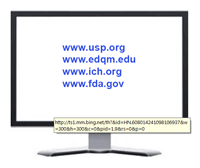This is the third instalment of HPLC Solutions related to resources you should have at your fingertips when you are working in an HPLC laboratory (see also #130 and #131). If you work in a regulated industry, such as pharmaceuticals, your HPLC methods likely will need to be validated. If you are using a compendial method from the United States Pharmacopoeia (USP) or European Pharmacopoeia (EP) or other pharmacopoeial method, you may not have to validate the method, but simply demonstrate that it passes system suitability. If the method is modified sufficiently in transfer, it will need some sort of validation.
Validation requirements are a little less clear for methods that are new to you, but have been validated by somewhere else, such as at another site in your company or perhaps by another laboratory. Requirements may depend on your company’s policy and standard operating procedures (SOPs). For example, many companies allow for methods to be transferred without revalidation as long as they are demonstrated to give the same results for a specific sample or set of samples. I once worked for a company that required full validation of all transferred methods because they wanted the entire validation data package to reside at the laboratory doing the analysis, so it would be convenient to access during a regulatory audit. You will have to validate methods, which you have created or existing methods that have been modified sufficiently, but the level of validation and the elements of validation usually vary depending on the application. For example, the validation process for a pharmaceutical content uniformity method will be quite different from a method for the determination of the same compound in human plasma.

Where do you find the requirements? The first stop should be your company’s SOPs. These should clearly state validation requirements and procedures that you can apply to specific methods. These SOPs should be based on your company’s interpretation of the regulatory documents on validation. There are two large categories of methods in the pharmaceutical industry: methods for drug substance (pure drug) or drug product (formulated drug) and methods for the drug in a biological matrix (usually referred to as “bioanalytical” methods). The International Conference on Harmonization (ICH) is the primary reference for the former and the United States Food and Drug Administration (FDA) is the source for bioanalytical methods.
The ICH has published a series of “Q” documents that relate to quality aspects of the pharma industry. Of particular interest for validation is ICH Q2(R1), “Validation of Analytical Procedures: Text and Methodology.” This contains definitions of precision, accuracy, linearity etc. as well as validation requirements for different method types. Although some specific requirements are included (such as n = 3 injections at n = 3 concentrations), user judgment is required. For example, it isn’t necessary to determine the limit of detection (LOD) if the method will only be used at high concentrations, such as a dissolution method. And, although specific requirements are listed, there is an acknowledgement that “one size doesn’t always fit all,” with allowance for alternate approaches. For example, the introduction of Q2(R1) includes this quote, “Approaches other than those set forth in this guideline may be applicable and acceptable. It is the responsibility of the applicant to choose…” My interpretation of this is that if you follow the Q2(R1) instructions exactly, the validation process should be acceptable. If you deviate from the instructions, you need to document the process more carefully, including a written justification about why you made certain choices.
The FDA document most relevant to methods for the determination of drugs in biological matrices is “Guidance for Industry: Bioanalytical Method Validation.” This document is much more general than the Q2(R1) document, and addresses the general areas that must be validated and suggestions about what the process should look like. It requires more user input to the exact design of the validation protocol. And here, as well as for the ICH, allowances are made for situations where the guidelines don’t fit well. Just be sure to document well.
In any case, the validation process should be in three parts:
(a) describe what experiments will be done and what the acceptance criteria are (this is the validation protocol),
(b) perform the validation experiments by following the protocol, and
(c) write a validation report summarizing the results of the validation experiments, including sample data and specific demonstrations that the method passes each of the validation criteria.
Where do you obtain the documents? Your SOPs, of course, can be obtained from your company’s quality unit. The USP and EP documents come from the specific organization, and will require a subscription to access them. These agencies, however, use the ICH documents as the basis of their validation sections. You can get the ICH documents from the ICH (www.ich.org). The FDA guidelines are available from the FDA website (http://www.fda.gov/Drugs/GuidanceComplianceRegulatoryInformation/Guidances/). You can also find the ICH documents linked from the FDA website, so this usually is my go-to website. Both the ICH and FDA documents are available free of charge.
Another source of validation information are books on the subject, which is the topic of the next instalment of HPLC Solutions.
This blog article series is produced in collaboration with John Dolan, best known as one of the world’s foremost HPLC troubleshooting authorities. He is also known for his research with Lloyd Snyder, which resulted in more than 100 technical publications and three books. If you have any questions about this article send them to TechTips@sepscience.com




